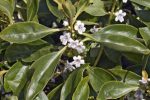 Mousehole tree is a evergreen shrub or small tree endemic to coastal areas and lowland forests of New Zealand but was introduced into the US as an ornamental and is found in coastal regions, woodlands, and riparian area along coastal California and in the San Francisco Bay area where it is considered invasive. It is a member of the figwort family, Scrophulariaceae, that also includes butterfly bush (Buddlea), twinspur, and Verbascum. The plant grows fifteen to thirty feet tall and has thick, corky, furrowed bark and dark green, glossy leaves that are two to four inches long, fleshy, lanceolate , and covered with translucent dots. The 5/8” bell-shaped flowers are white with small purple spots, slightly fragrant, and carried in clusters of two to six from mid-spring to mid-summer. Fruits are round, 1/3”, and reddish purple. Plants are tolerant of alkaline and saline soil, and strong winds but are currently being threatened by Myoporum thrips (Kambothrips myopori) although the cultivar ‘Clean and Green’ is resistant. The seeds of mousehole tree are poisonous to some livestock. The generic name, Myoporum, comes from the Greek words myein meaning to close, and proum meaning pore. The specific epithet, laetum, comes from the Latin word meaning pleasant.
Mousehole tree is a evergreen shrub or small tree endemic to coastal areas and lowland forests of New Zealand but was introduced into the US as an ornamental and is found in coastal regions, woodlands, and riparian area along coastal California and in the San Francisco Bay area where it is considered invasive. It is a member of the figwort family, Scrophulariaceae, that also includes butterfly bush (Buddlea), twinspur, and Verbascum. The plant grows fifteen to thirty feet tall and has thick, corky, furrowed bark and dark green, glossy leaves that are two to four inches long, fleshy, lanceolate , and covered with translucent dots. The 5/8” bell-shaped flowers are white with small purple spots, slightly fragrant, and carried in clusters of two to six from mid-spring to mid-summer. Fruits are round, 1/3”, and reddish purple. Plants are tolerant of alkaline and saline soil, and strong winds but are currently being threatened by Myoporum thrips (Kambothrips myopori) although the cultivar ‘Clean and Green’ is resistant. The seeds of mousehole tree are poisonous to some livestock. The generic name, Myoporum, comes from the Greek words myein meaning to close, and proum meaning pore. The specific epithet, laetum, comes from the Latin word meaning pleasant.
Type: Flowering evergreen shrub or small tree
Outstanding Feature: Flowers, foliage
Form: Oval crown
Growth Rate: Moderate to rapid
Bloom: Clusters of 2-6 bell-shaped 5/8” slightly fragrant white flowers with purple spots from mid-spring to mid summer
Size: 15-30’ H x 20- W
Light: Full sun
Soil: Average, moist to dry, well-drained
Hardiness: Zones 9-11
Care: Prune when young to establish structure and shape.
Pests and Diseases: Thrips
Propagation: Fresh seed, semi-hardwood cuttings